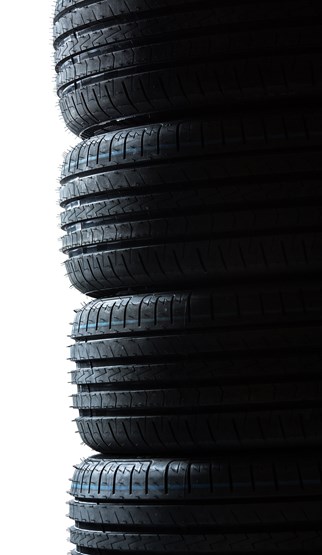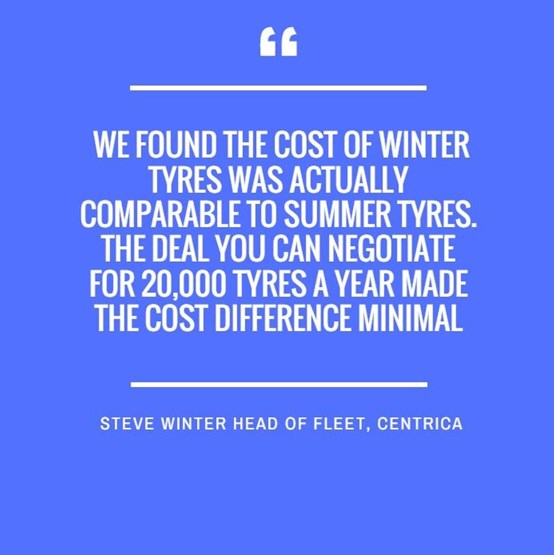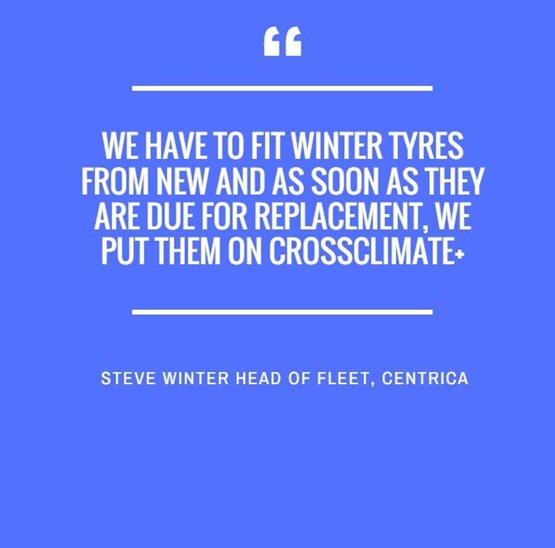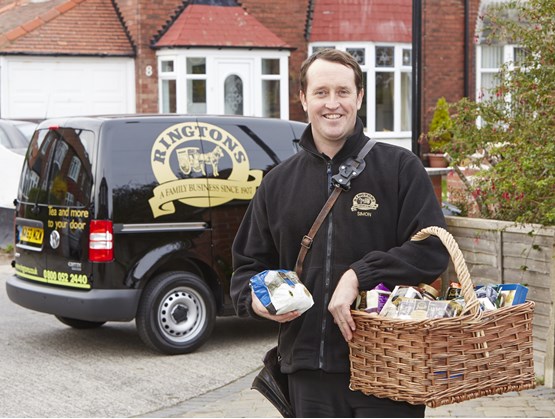The new generation of all-season tyres could offer fleets all the benefits of winter tyres but without the drawbacks. Andrew Ryan reports

The concept of changing tyres dependent on the season has never really caught on among UK fleets. The theory seems sound.
Winter tyres are designed to cope with the kind of conditions the so-called ‘Beast from the East’ threw at the country last month, improving safety and keeping vehicles on the road: particularly desirable for bluelight fleets, utilities engineers and delivery companies.
When the warmer weather comes, they can be switched for summer tyres which offer greater grip, reduced wear and improved fuel economy in temperatures above 7C, giving fleets the best of both worlds.
But the reality is complicated: the downsides of switching tyres include the cost, increased vehicle off-road time and whether winter tyres are really needed for the UK’s comparatively mild winters.

These factors have deterred the vast majority of fleets from adopting the technology.
However, a new generation of ‘all-season’ tyres, such as the Michelin CrossClimate+ and Continental AllSeasonContact, could offer fleets an appropriate all-year round solution.
Both CrossClimate+ and AllSeasonContact, as well as the Yokohama BluEarth-4S AW21 – the first all-season tyre the manufacturer has launched in Europe – are winter certified for use on snowy roads.
CrossClimate+ has the 3PMSF (Three Peak Mountain Snowflake) certification, with both the AllSeasonContact and BluEarth-4s AW21 bearing the equivalent ‘snowflake mark’ awarded by ASTM International (American Society for Testing and Materials).
This winter capability, coupled with strong performance in the warmer and drier months, could prove to be the final nail in the coffin for dedicated winter tyres in the UK.
READ MORE: Michelin CrossClimate+ wins prestigious tyre test
“In about 80% or 90% of the tyre sizes where we have CrossClimate+, it has virtually killed the winter car tyre demand off in the UK,” says Jamie McWhir, technical manager at Michelin.
“It’s a more simplified product offer: you’ve always got the right tyre on the car.”
McWhir says that internal Michelin testing has shown that CrossClimate+’s winter performance is within 5% of its Alpin dedicated winter tyre, almost rendering Alpin irrelevant for the UK market.
“Unlike some European countries, we don’t have legislation where motorists need to fit winter tyres for part of the year and we don’t have a market where consumers are used to buying winter products,” he adds.
“The Beast from the East was fairly unique, but other parts of Europe have that sort of weather every year and they have it for months.
“In those countries having that extra 5% of grip is important, so they will run a winter product. But for us, we never have that bad a winter.”

One fleet which has made the switch from alternating between winter and summer tyres to fitting all-season tyres is South Western Ambulance Service NHS Trust.
It now fits CrossClimate+ to its 200-strong fleet of Škoda Octavia rapid response vehicles.
“We only take vehicles off the road for safety inspections or maintenance, and the six-week transition period previously required to swap our summer and winter tyres twice a year was incredibly inconvenient,” says Kevin Bartholomew, fleet operations manager at the trust.
“We can now keep the same tyres on the Škodas year-round, saving time and money.
“Lives depend on ensuring safe mobility for our fleet, so we simply can’t afford for tyre-related downtime or lack of grip in snow, ice and rain to delay us on a call-out.
“Fitting CrossClimate+ tyres means we can supply expert lifesaving care, whatever the UK’s unpredictable weather throws at us.”
British Gas also made the switch to all-season tyres for its small vans around three years ago.
Since 2010, it had fitted winter tyres to its 12,500-strong van fleet for three reasons: driver safety, the extra mobility which meant it could attend customer call-outs in adverse weather conditions and the company’s total cost of ownership (TCO) model around four-wheel drive vans.

“We were paying for four-wheel drive vans all year round for the benefit they would bring us for the couple of weeks when they really needed to be used,” says Steve Winter, head of fleet at Centrica.
“We also had to hire 4x4s as well, so we would pre-rent them from hire companies on the understanding it might snow and we might need that 4x4 ability.”
This was expensive, says Winter, and as its tyre supplier Michelin had winter tyres available, it trialled these on a number of vehicles.
“We found we could take that tyre as an option from the OEM, so we took the decision to fit everything with winter tyres,” he adds.
“We decided that we run the winter tyres all year round and not hotel (store) tyres at all because it would be costly, as well as avoid having to go from summer tyres to winter tyres and back again.
“We found the cost of winter tyres was actually comparable to summer tyres. The deal you can negotiate for 20,000 tyres a year made the cost difference minimal.”
The extra traction afforded by the winter tyres allowed British Gas to reduce the number of four-wheel drive vans on its fleet. “We don’t hire anything unless it’s very arduous conditions,” adds Winter.
When Michelin launched the original CrossClimate in 2015, British Gas fitted these extensively to its Volkswagen Caddy fleet. CrossClimate was succeeded by CrossClimate+ last year.
“As well as having the advantages of a summer tyre and winter tyre in one, it was actually cheaper than a dedicated winter tyre, so we moved on to that when it became available,” says Winter.
“The longevity of that tyre also outperforms any other on the fleet – the winter tyre, no doubt, but the summer tyre as well.”

However, while it now fits CrossClimate+ across its Caddy and Ford Transit Connect vehicles, it still fits winter tyres to its larger vans such as Transit Customs and Vauxhall Vivaros as the CrossClimate technology was not available in the right tyre sizes.
Many fleets have also adopted the practice of running winter tyres all year round on vans as they consider the benefits of the extra grip in bad weather to outweigh any penalty of increased tyre wear and fuel consumption in the warmer months.
One of those fleets is online supermarket Ocado, which fits its home delivery fleet of more than 1,500 Mercedes-Benz Sprinter vans with Bridgestone Blizzak winter tyres.
“Staying with a tyre all-year round was desirable, following our own reviews and the nature of the journeys we make,” says Graham Thomas, fleet service manager at Ocado.
Traditionally, operating winter tyres in the warmer months has led to a noticeable drop-off in performance and fuel economy, while wear is also accelerated, but McWhir says developing technology means these penalties are reduced.

“The tyre compound is obviously more suited to colder temperatures, so if it is 20C in July, the wear is a little faster than a summer tyre, but not at such an accelerated rate as it used to be,” he adds.
“There was never a compromise from the point of view of safety and manoeuvrability from running a winter tyre in the summer, it may be just slightly increased wear.”
However, some fleets have had different experiences. One has seen a 30% reduction in tyre wear across its 1,600-strong fleet of CVs, while British Gas saw no increase in wear when it fitted winter tyres all year round to its vans.
Nevertheless, British Gas plans to switch to the van version of CrossClimate – called Agilis CrossClimate – after it is launched in the UK in May.
“I wouldn’t go back to summer tyres now,” says Winter. “Our TCO model is saying we need to alter our tyre policy because budgeting for winter tyres is no longer relevant because CrossClimate+ means we are spending less on tyres than we were.”
Winter says the main issue British Gas has experienced with CrossClimate+ is that the vehicle manufacturers will not supply their vans with them fitted.
“We have put a lot of pressure on manufacturers to supply the tyres as OEM, but this has not been possible,” he says.
“We have to fit winter tyres from new and as soon as they are due for replacement, we put them on CrossClimate+.”

Compared to summer tyres, winter tyres (also known as cold weather tyres) have rubber compounds which remain soft under low temperatures.
The softer they are, the more the tyre is able to interlock with the road surface, improving grip and handling.
In comparison, summer tyres have a relatively hard compound which softens in milder temperatures to be able to adapt to dry as well as wet roads.
However, as they use less natural rubber than winter tyres in their construction, their compound begins to harden at temperatures below 7C, reducing grip.
Summer and winter tyres also feature vastly different grip patterns. Summer tyres tend to have a simple block-shaped tread pattern providing a large footprint on the road, which improves grip and can have a massive impact on the braking distances on dry roads.
Winter tyres, however, have a deep tread pattern and feature thousands of tiny grooves (known as sipes) in their tread blocks which bite into the snow, slush and ice, improving grip.
READ MORE: Centrica signs three-year fuel card deal with Barclaycard and TMC
All-season tyres aim to provide the best of both worlds. For example, Michelin says its CrossClimate range uses an ‘intelligent new mix of compounds’ to create a tyre that is soft enough for summer, but doesn’t harden when the temperature drops below 7C.
It also says its V-shaped tread pattern with self-locking sipes maximises grip whatever the weather conditions.
Continental says the traction silica compound used in its AllSeasonContact range ensures the tyre always stays flexible, whatever the temperature.
Case study: Ringtons

Tea company Ringtons fits Michelin CrossClimate+ tyres across its fleet of 230 Volkswagen Caddy vans and 30 company cars to improve employee safety and mobility.
The business delivers tea, coffee, biscuits, gifts and homeware from 35 sites to homes throughout the UK, as well as supplying wholesalers, hotels, businesses and restaurants.
“Safety is a big thing for us and we need to ensure our drivers are as safe as possible,” says Stephen Killinger, operations manager of Ringtons.
“A lot of bluelight fleets are fitting the CrossClimate because they do make a difference.
“Yes, they are costing us a few pounds more than the tyres we fitted previously, but we feel it is worth it because you can’t put a price on safety and the ability just to get around in the weather that we have seen over the past few weeks.
“The weather was pretty harsh for a short period of time and the tyres were fantastic – that’s the feedback that’s come back to me from our guys around the business. They said those tyres really do make a difference.”
Killinger says the all-season tyres were also proving to be more durable than the Michelin summer tyres they had previously used.
Its previous tyres needed to be replaced after 6,000 to 7,000 miles, while CrossClimate is lasting for around 10,000.
Killinger says the company had previously trialled dedicated winter tyres, but concluded that they wouldn’t be cost-effective because of the cost of storing the sets of tyres which weren’t being used.
 Back in 2010, after a particularly bad cold spell, fleets began to take a serious look at the notion of changing tyres in winter to increase safety and mobility.
Back in 2010, after a particularly bad cold spell, fleets began to take a serious look at the notion of changing tyres in winter to increase safety and mobility.
Yet today, thanks to the arrival of the Michelin CrossClimate range, winter tyres can almost be considered unnecessary for many fleets.
What makes the latest generation Michelin CrossClimate+ fitments unique is that they are NOT all-season tyres… or ‘no-season tyres’ as some have been known to call them (given most sacrifice top-level performance to work only marginally well year-round).
CrossClimate+ tyres stand apart for offering the benefits of a summer tyre for dry and wet braking, energy efficiency and total mileage, while boasting the braking and traction of a winter tyre on cold, wet or snowcovered roads.
Rigorous tests
They have even been heralded as “exemplary” after triumphing in rigorous, competitive tyre tests carried out last year in Germany by Auto Bild magazine – further elevating their reputation for unrivalled longlasting performance.
Auto Bild staged what it believes were the first published indepth tests comparing the performance of different tyres as they wear. It pitted CrossClimate+ against allseason fitments from five competitors* at three tread depths – 8mm (new), 4mm and 2mm.
Commenting on the wet braking results, Auto Bild testers said: “It’s remarkable that the 2mm Michelin brakes better than most candidates with 4mm remaining tread.” And when it came to winter handling, they said “only the Michelin delivers safe handling with 2mm of tread”.
Michelin is committed to expanding its CrossClimate range, with car and carderived van fitments available from 14 to18 inches, expanding to 19 inches later this year.
CrossClimate SUV tyres are available in16 to19inch sizes, and soon increasing to 20 inches. From May, we’ll be introducing the first Agilis CrossClimate tyres for vans – bringing a new level of safety and mobility to these fleets, and without the costs or downtime of running two sets of tyres.
* Tested by Auto Bild magazine alongside Michelin CrossClimate+ 92 V were the following t yres – Goodyear Vector 4Seasons Gen-2 88 T, Pirelli Cinturato All Season 88 H, Hankook Kinergy 4S 88 T, Vredestein Quatrac 5 88 T & Nokian Weatherproof 88 T. Tests measured tyres’ performance in the following handling disciplines: Snow – traction, slalom, braking and handling; Wet – aquaplaning, skid pan, braking and handling; and Dry – handling, braking, drive-by noise and rolling resistance.





















Login to comment
Comments
No comments have been made yet.